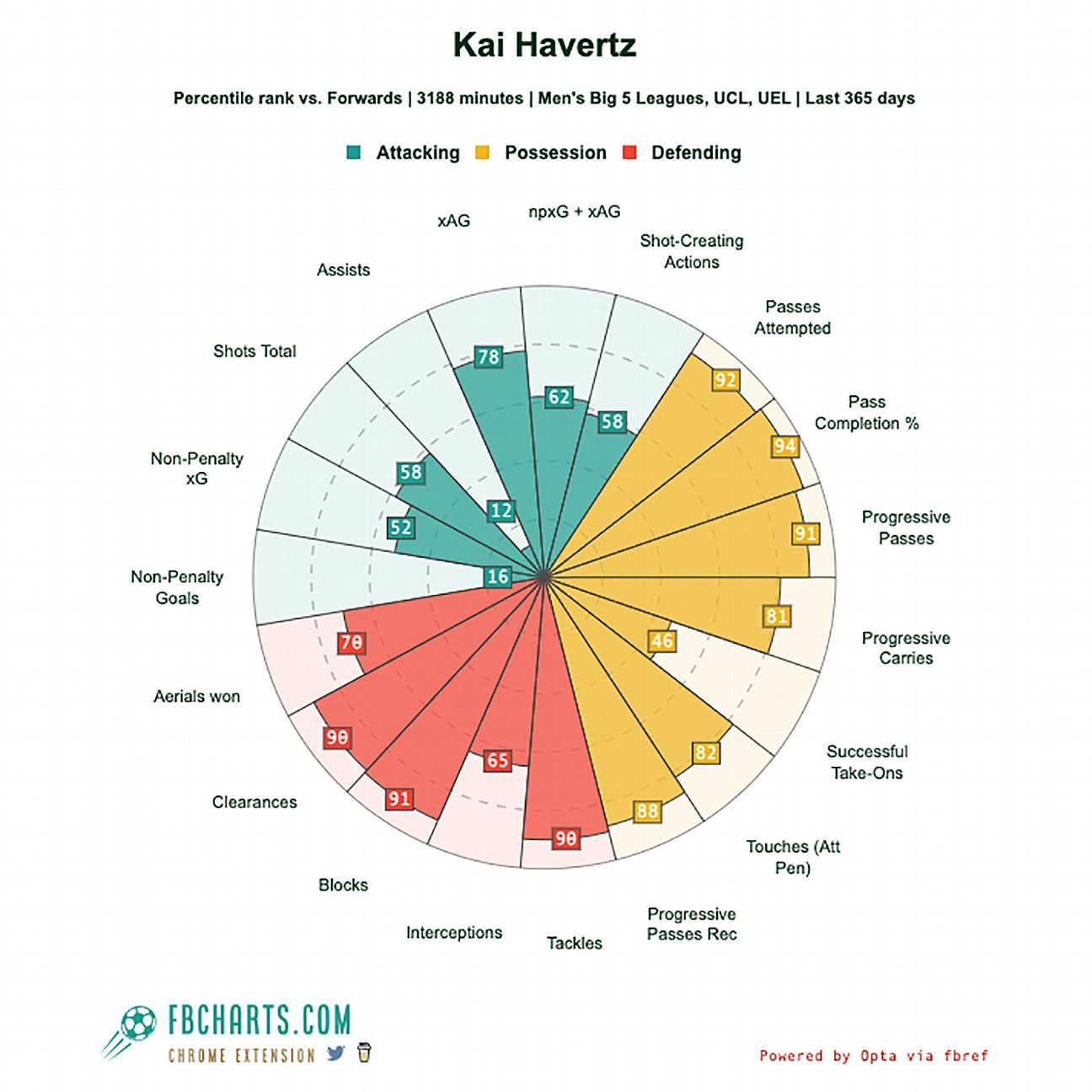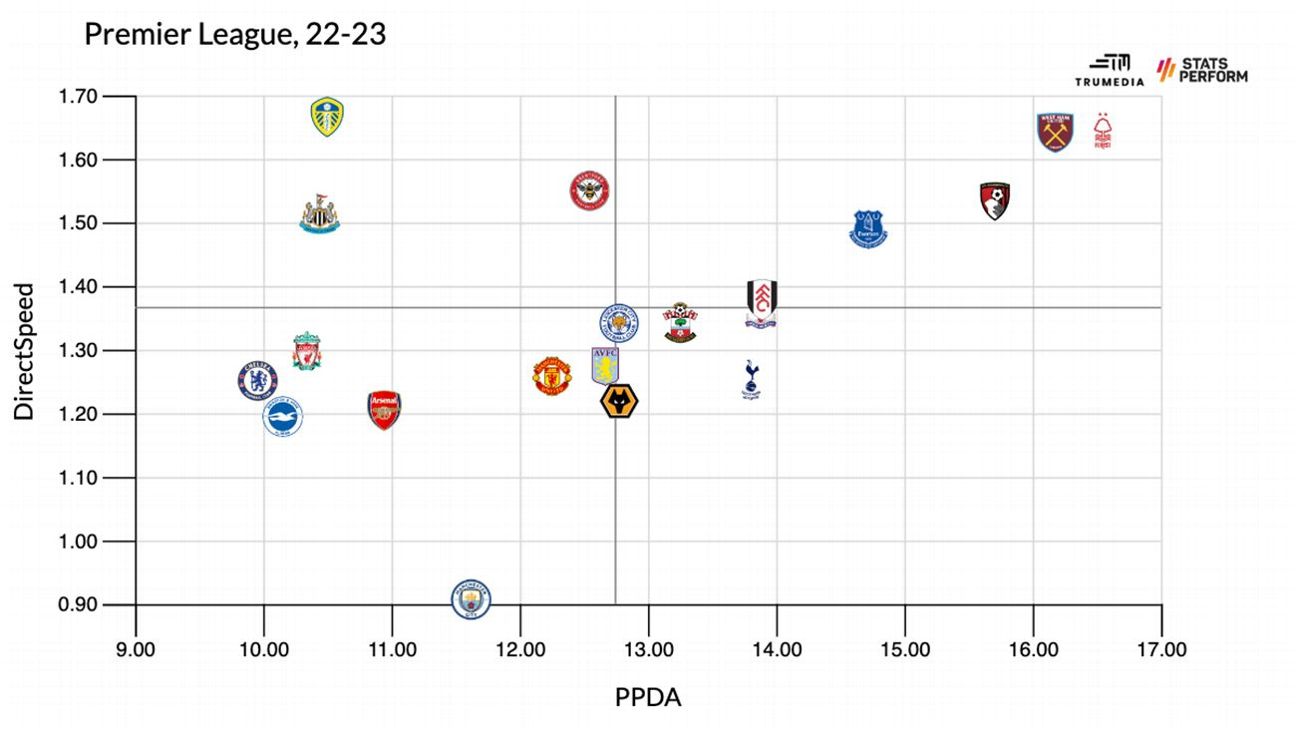Arsenal were close to winning the Premier League title last season — but how close?
In one sense, they were closer than anyone who didn’t get there has ever been. Despite finishing second to Manchester City, Mikel Arteta’s side led the division for 248 days. Even though the season only lasted from August to May, the Gunners were top of the table for more than two-thirds of a year — and they still didn’t win.
However, the progression of the calendar can fool you into thinking you saw something that wasn’t quite there. Across the entirety of the 38-game season, Arsenal were closer to the teams in fourth or fifth than the one in first. Their goal differential (+45) was nearer to Newcastle United‘s (+35) than it was to City’s (+61). Their expected-goal (xG) differential (+29.9) was worse than Newcastle’s (+32.4), and closer to both Liverpool‘s (+21.7) and Brighton & Hove Albion‘s (+23.1) than it was to City’s (+46.6).
Perhaps a front-loaded schedule — both in the number of games and the quality of the opposition — and some white-hot finishing (88 goals scored from 71.9 xG) created the feeling of a title race that wasn’t quite as competitive as it seemed.
However you choose to frame last season’s title challenge from Arsenal will frame how you feel about a potential follow-up next season. But how you, or I, frame it doesn’t really matter much. Arsenal have already signed Kai Havertz and are expected to finalize a deal for Declan Rice within a matter of days, with those two transfers set to cost them around £170 million ($215m).
So we already know how Arsenal are framing it. They think they’re this close.
A new approach?
One of the driving factors behind Arsenal’s unexpected title push last season — and their subsequent collapse — was the small group of players who featured every week. Across their 38 games, they used 22 different starting XIs, the lowest number in the league. Eleven players featured in at least 60% of the club’s league minutes, while no one else even appeared in a third of the available minutes. Per Ryan Best of FiveThirtyEight’s STABLE metric, which quantifies “how similar each team looked every time it took the pitch,” Arsenal were, well, the most stable team in the league in 2023.
Arsenal were able to massively over-perform preseason expectations, in part because they had their key players available for an unexpected number of matches. And their late-season collapse — three wins from their final nine matches — came in part because Arteta was unable to rely on the same set of players as attrition began to take its toll. The reliance on that core, however, makes it relatively easy to pinpoint who Arsenal’s key players were; it’s those 11 guys.
Here’s how much they were all acquired for and at what age they joined the club, per data from Transfermarkt:
The average age of those players is 22.1 years, and the average fee paid for all 11 is €34m. Transfer fee isn’t the full cost of acquiring a player — academy graduate Bukayo Saka does not do pro bono work for Arsenal — but the aggregate numbers still paint a decent picture of the overall approach. The best Arsenal team since at least 2016 was built with mostly mid-tier fees paid for young players. Although Granit Xhaka is the only player who joined during the Arsene Wenger era, the only real outlier is Thomas Partey, who arrived toward the end of his prime, for more money than all but two other players, and was paid a team-high salary.
That move didn’t work out; Partey has featured in fewer than 60% of the Premier League minutes in his three seasons with the club, and reports suggest they’re trying to move on from him this summer. Xhaka, meanwhile, has been a first-team fixture in his seven seasons with Arsenal — 78% of Premier League minutes — but like Partey, he’s 30 and also seems like he’s on his way out.
The other nine? They’ll all be 26 or younger at the start of next season. And while the likely replacements for Partey and Xhaka will fit right into that same bracket — they’re both 24 — Havertz and Rice still represent a departure from the way the club had been doing things. At the reported fees, they’ll be two of the three most expensive players in Arsenal history.
Are they worth it?
Every transfer fee paid represents a confluence of factors, but each one also represents a degree of certainty. Or at least, it should. Given that you’re paying a fee just to have a player break his contract with his previous team and sign a new one with you, the more you’re willing to pay, the more confident you should be that the player you’re signing is going to provide a certain amount of value to your team.
Of course, this isn’t how it works out in practice.
“On average, record signings play 50% of the minutes at their club,” Omar Chaudhuri, head of intelligence at the consultancy 21st Group, told me. “Half of them become bench players. It’s kind of staggering.”
It’s been no different at Arsenal. Their past four record signings were Mesut Ozil in 2013, Alexandre Lacazette in 2017, Pierre-Emerick Aubameyang in 2018 and Nicolas Pepe in 2019. On the whole, Ozil was a success; he’s one of the best creative players in Premier League history. But Lacazette and Aubameyang only played about 60% of the league minutes while at the club, and Pepe — the club’s record signing until the Rice deal is finalized — didn’t even feature in a third of potential game time.
Should we expect the same from Rice and Havertz? Unlike Lacazette and Aubameyang, they’ve both been acquired at the beginning of their prime years. And unlike all three, each player has multiple years of starting experience in the Premier League under his belt. But there’s still plenty of projection required for both of them.
Let’s start with Havertz. He’s a weird player, which means he’s a polarizing player. At Chelsea, he’s been a center-forward who does pretty much everything other than score. That’s fine when paired with high-scoring and high-functioning wingers, neither of which Chelsea had this past season.
Here’s how his stats compare to other forwards across Europe’s top five leagues over the past 365 days:

If you’re looking at those numbers and thinking, “Not many goals or assists but a ton of great forward passing and ball-winning — that smells like a midfielder,” then you might actually be Mikel Arteta. It appears as if the Arsenal manager envisions Havertz as a direct Xhaka replacement, though he should be able to play functional minutes at center-forward, too.
Back in February, I wrote about how managers might benefit from experimenting more with moving players into new positions and how that could be a way to find value in the transfer market. In theory, there’s nothing wrong with signing a player to play a different position for your team; it’s just that Arsenal aren’t getting any kind of discount by doing it.
Until Rice officially joins, Havertz is the second-most expensive player in Arsenal history. The only midfielders who went for higher fees at any club are Aurelien Tchouameni, Jude Bellingham, Enzo Fernandez and Paul Pogba. You might have thought that with all the dysfunction at Chelsea — and with Havertz’s strange skill profile — he could have been available at a discount. But Arsenal are paying an amount that suggests there’s little doubt he’s going to be a star, though they see it happening at a position he hasn’t ever played before.
The details are different, but the point remains the same with Rice. The Gunners are planning to make him the club-record signing, and he’d be the second-most expensive midfielder of all time and the seventh-most expensive player at any position. This suggests an even greater feeling of certainty in a role (deep-lying midfielder) that historically hasn’t cost as much or moved the needle as much.
For example, Chelsea paid just slightly more for Enzo in January, and he was fantastic. He did everything you want from the position: he won the ball, never lost it, and constantly pushed play forward. Despite that, Chelsea’s results remained terrible even after he started to play every minute of every game for the team. And Rice has a broadly similar profile to Enzo.

Although we’ve seen 17,000 minutes of steadily improving play from Rice at West Ham, that’s a very different environment from what we’ll see at Arsenal. With the Hammers, Rice had a ton of space on the ball and didn’t have to cover as much space off of it thanks to the team’s fast-paced style of play. At Arsenal, it’s going to be the exact opposite: little space when he has the ball, lots of space to defend when he doesn’t. This chart, plotting how aggressively teams press (passes allowed per defensive action, PPDA) against how quickly they move the ball up-field in meters/second, shows just how far apart the two teams were last year:

The problem with getting better is that it then requires better players to improve your squad, and better players typically do cost more money. Rice and Havertz make the team significantly younger and fit better with the age profile, but there’s also a world where neither Havertz nor Rice are better than Xhaka or Partey — both of whom had their best-ever seasons in an Arsenal shirt — were last season.
At least, there’s no guarantee that either one is better than, or even as good as, the guy he’s replacing. Plus, spending so much money on just two players limits your ability to build depth, the thing that the club badly needed last season and will require even more of with Champions League games this season.
However, the upside is significant. Rice could single-handedly solves the defensive issues that Arsenal had in the second half of the season without requiring any changes elsewhere that might muffle the attack, Havertz might be the next Ilkay Gundogan and you have both players doing those things for the next five years while the likes of Saka, William Saliba and Gabriel Martinelli all continue to improve. If all of that happens, Arsenal will be challenging for a title next season, and the season after that, and the season after that…
While the history of the transfer market tells us that we shouldn’t expect all of that to happen, the Gunners have convinced themselves to ask a more tantalizing question: But what if it does?
Credit: Source link